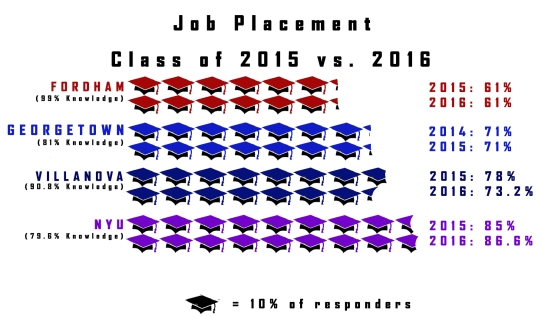By Theresa Schliep

59 percent of the class of 2016 gained full-time employment and 10 percent are still looking for work (Courtesy of Andrea Garcia / The Fordham Ram).
Job placement outcomes for the undergraduate schools remain constant from last year as one in 10 in the class of 2016 still seek employment six months after graduation, according to the Office of Institutional Research.
The report reveals that 59 percent of the class of 2016 gained full-time employment, while 10 percent are still seeking work. These numbers remain consistent with the 2015 Placement Report, which detailed the job outcomes of the class of 2015.
In comparison, Georgetown’s 2015 placement report boasted a 69 percent full-time employment rate, while Villanova compared with 73.2 percent full and part time employment and New York University with 86.6 percent full and part time employment for their 2016 placement reports.
The office published its 2016 Placement Report last week based on information collected on 99 percent of the class, which the office considers an “exceptionally high knowledge rate.”
There was a three percent drop in students continuing education. While 20 percent of the class of 2015 pursued secondary education, 17 percent of the class of 2016 did the same.
The report also shows disparities between job placements of the Gabelli School of Business (GSB) and the Liberal Arts Colleges. 73 percent of the GSB class of 2016 are employed full-time, whereas 54 percent of Liberal Arts Colleges students are employed full time.
Ashley Domagola, FCRH ’16, graduated with her bachelors in political science and is now in the NBCUniversal Page Program. She said that it appears that Fordham is very helpful to students pursuing graduate school, but found that Career Services did not help her in finding jobs involving her interests.
“For people who didn’t want to go the grad school route, the options weren’t always available,” said Domagola, who had four internships while in college. “I was applying to various communications jobs with non-profits, government agencies and media companies.”
Jessie Robertson, FCRH ’16, is currently a video editor and story producer at NBCUniversal. She said that her experiences outside of the classroom at Fordham, such as her involvement with Fordham Nightly News, were crucial in her success after Fordham.
“I cannot stress the importance of the opportunities and experiences that Fordham provides outside of the classroom,” said Robertson. “They are 100 percent the reason I have a career today.”
Robertson said that she did not use Career Services, and Domagola also said that she and her peers at Fordham College Rose Hill (FCRH) by and large pursued internships through their own means.
“I knew these roles existed because I found internships in all of those areas, but the career services job search portal rarely had relevant jobs, and the same was true of the career fair,” said Domagola. “Many fellow students from FCRH would skip the career fairs because they’d look at the employer list and not see anything in their field.”
The mean starting salary for those employed full-time is $51,005, but the report notes that only 44 percent of students reported their salaries. The 2015 report found an average of $55,000, but only 34 percent of of the class of 2015 reported their salaries.
Robertson said Fordham’s strengths lay in its connections and name recognition.
“Fordham’s name itself helped me get my foot in the door,” said Robertson. “As a communications majorm juts being a Fordham student was held in high regard in many of the NYC media companies.”
Domagola also found Fordham’s reputation helpful in securing her position at NBC.
“I give a lot of credit to Fordham grads, because you can always find a Fordham alum in basically any field, and in my experience they are always incredibly generous with their time and advice,” said Domagola.
The report notes that data on student job placements prior to 2014 should be approached with “caution,” as the National Association of Colleges and Employers released standards and protocols for collecting job placement data.
“As Fordham’s earlier placement analyses did not use the same methodology, caution should be used when comparing the outcomes of classes prior to 2014 with those since then,” says the report.
The report also shows two percent seeking continuing education, two percent in artistic pursuits or auditions, two percent in public service, one percent in military service and four percent employed part-time.
Kasey Fausak, assistant director of experiential education with Career Services, said that Career Services is available for current and past students.
“Students have access to our resources forever,” said Fausak.

Show salary averages, industry, type of work.